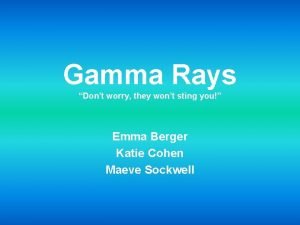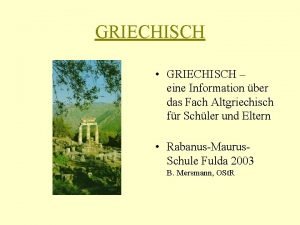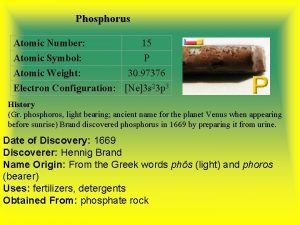Atomic Physics Radiation Contiuned Gamma Radiation Gamma radiation











- Slides: 11

Atomic Physics Radiation Contiuned

Gamma Radiation (γ) • Gamma radiation has no charge, so its ionizing power is much less then alpha and beta particles. • It is very energetic, being able to penetrate unlimited thickness of air, several meters of concrete and even several centimeters of lead. • Gamma radiation comes from when the nucleus of an atom returning to its ground state by emitting energy

Gamma Radiation Example: Uranium-238 decays by emitting an alpha particle, resulting in thorium-234 having excess energy, and emitting a photon of gamma radiation to return to the ground state.


Radioactive in E-Field Explain what’s going on here. Gamma has no charge, so no deflection Alpha and beta have charges, alpha less charge then beta, alpha and beta have opposite charges, beta has a range of energies

Radiation creating Radiation The daughter nuclide of a radioactive decay may, itself, be unstable and emit another radioactive nuclide. This is called a radioactive decay series

Detecting Radiation from ionizing properties Geiger counter – When radiation enters the window it makes ion pairs with gas inside the tube. These particles cause further ionization, resulting in the avalanche effect.

Detecting Radiation from ionizing properties Photographic plates – Radiation strikes a photographic film, reacting as if it has been exposed to light. This creates “fogging” on the film to detect radiation.

Detecting Radiation from ionizing properties The Scintillation counter – A zinc sulfide coated glass. Radiation emits a tiny pulse of light when reacting with the zinc sulfide, called a scintillation. Faster the pulse, higher the intensity of radiation.

Background Radiation • Radiation is natural, and is everywhere. Rocks contain small amounts of radiation, so do several foods we eat, even our bodies are natural radioactive. • Some comes from cosmic radiation, but most is from man made sources. These sources come from medicine, fallout from nuclear explosions and power stations leak. • The sum of all this radiation is called background radiation.

Background Radiation
 Who discover gamma rays
Who discover gamma rays Atomic number vs atomic radius
Atomic number vs atomic radius Ionization energy trend periodic table
Ionization energy trend periodic table Mass of oxygen
Mass of oxygen Relative atomic mass of beryllium
Relative atomic mass of beryllium Differentiate between atomic number and mass number
Differentiate between atomic number and mass number Chemistry periodic trends
Chemistry periodic trends Modern physics vs classical physics
Modern physics vs classical physics University physics with modern physics fifteenth edition
University physics with modern physics fifteenth edition Simple physics ia ideas
Simple physics ia ideas Eta sigma gamma csuf
Eta sigma gamma csuf Lateinisches alphabet alpha beta gamma
Lateinisches alphabet alpha beta gamma





















